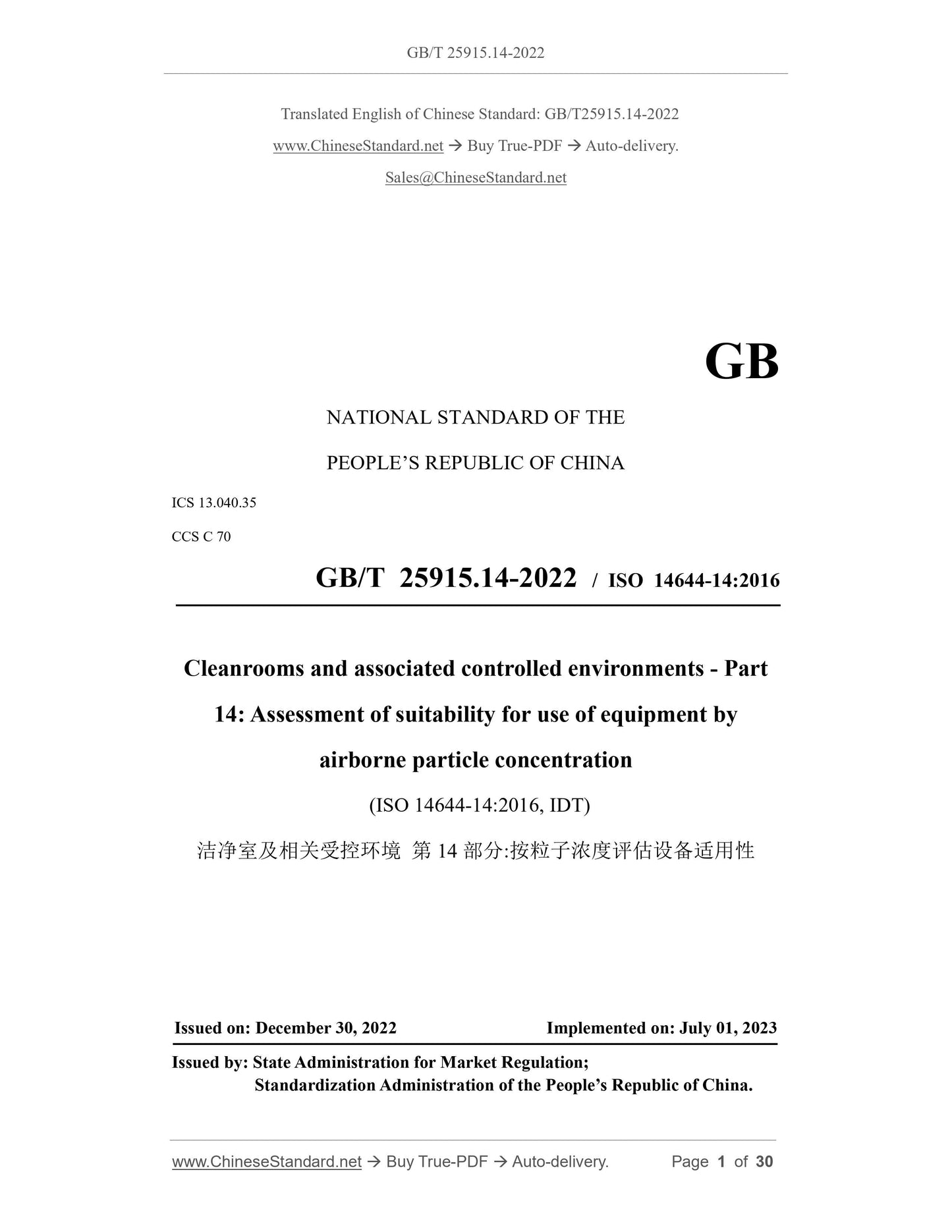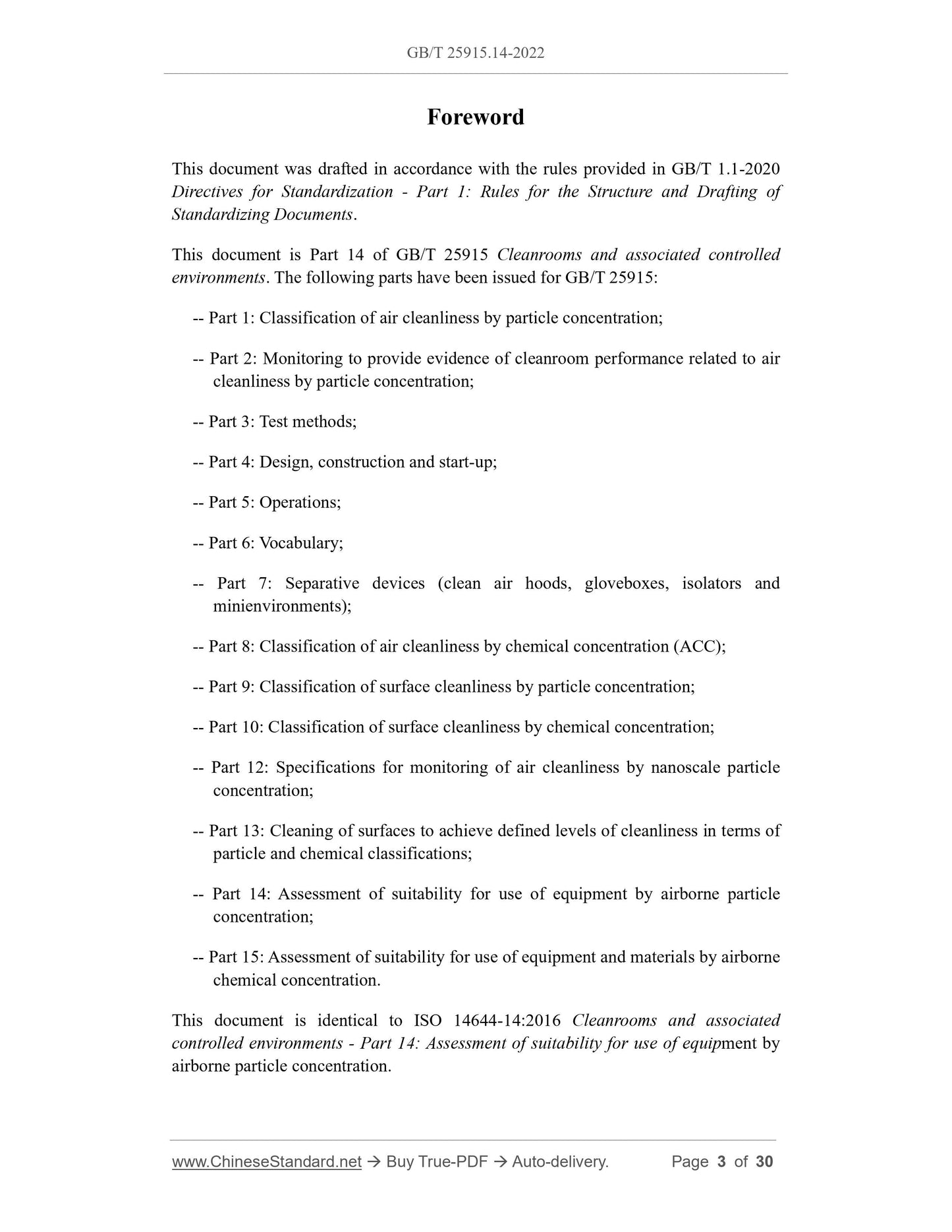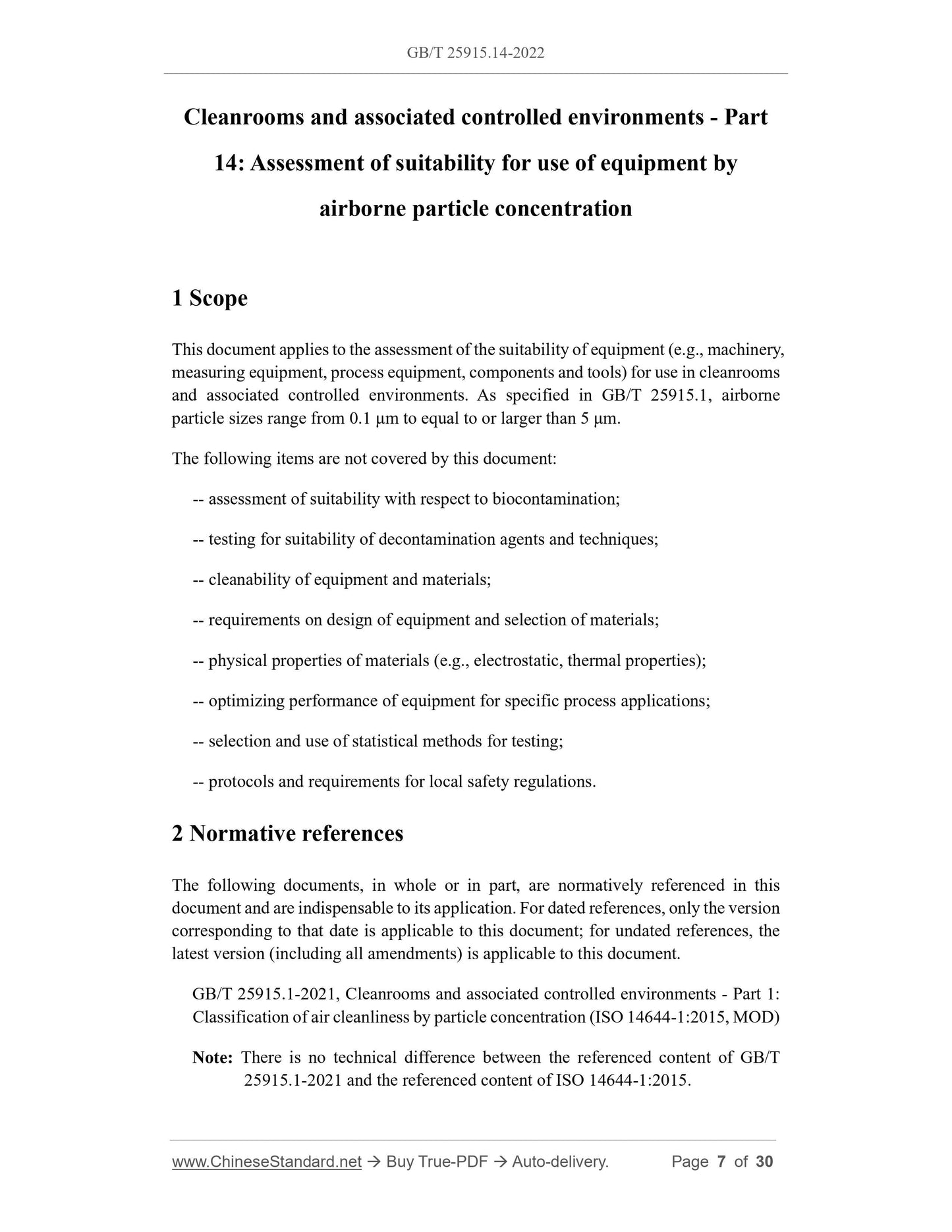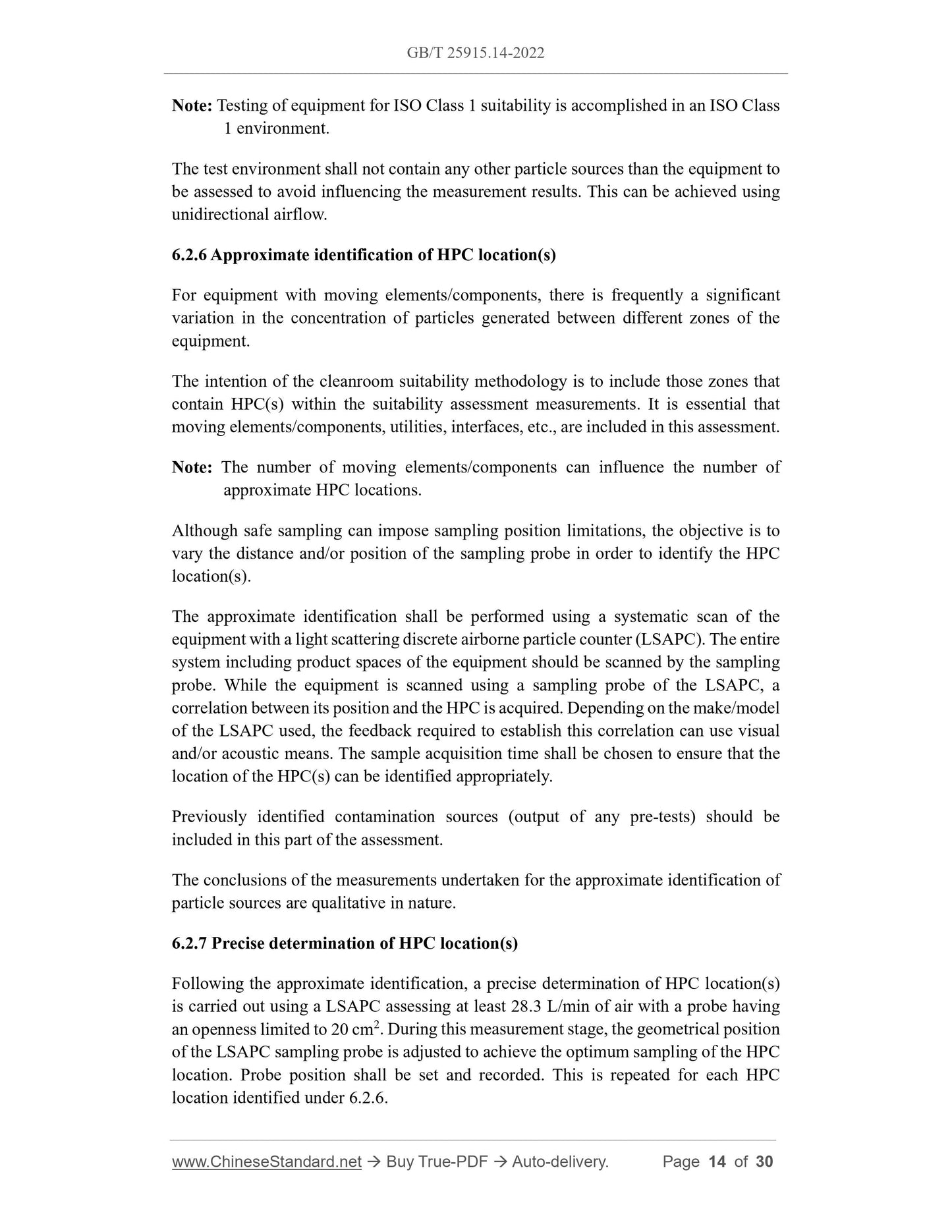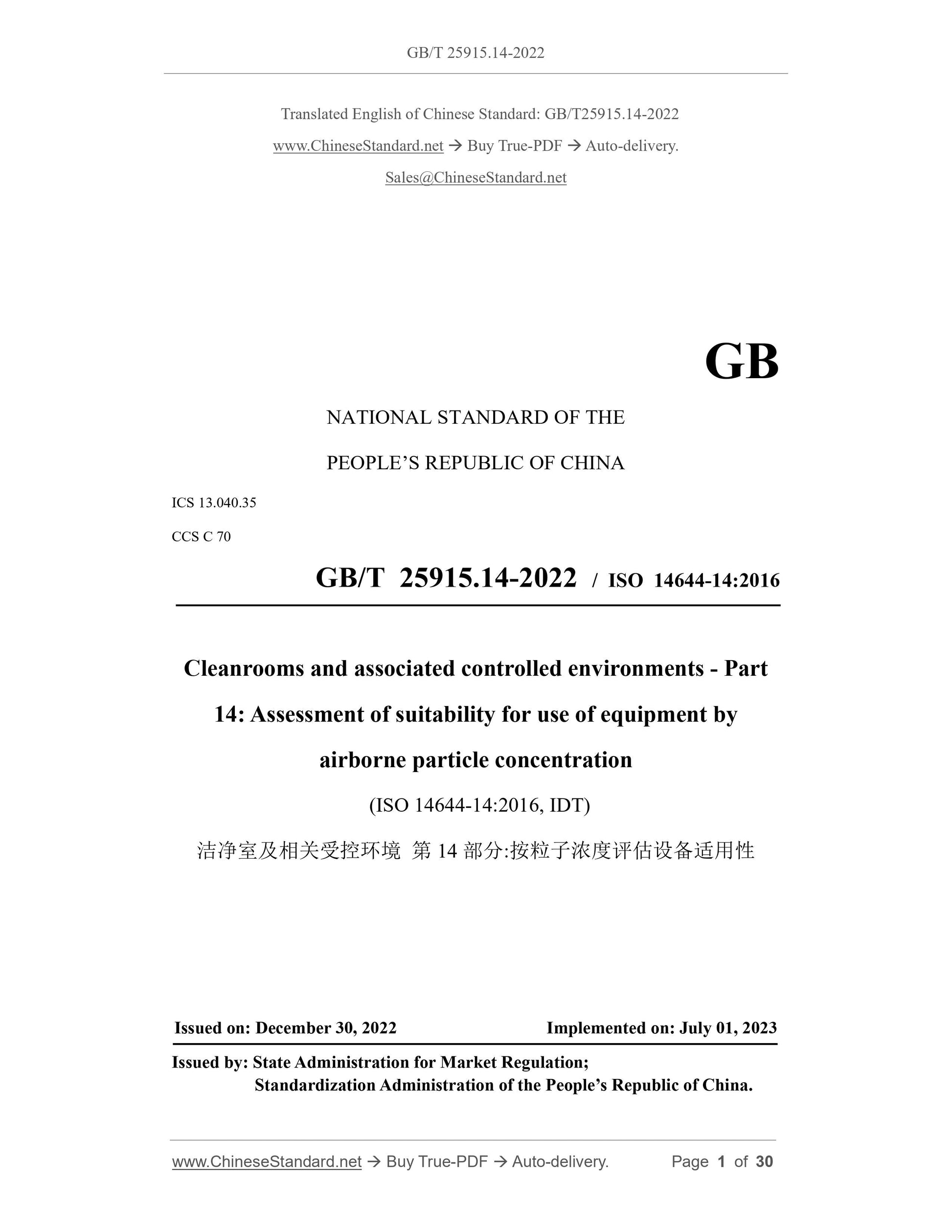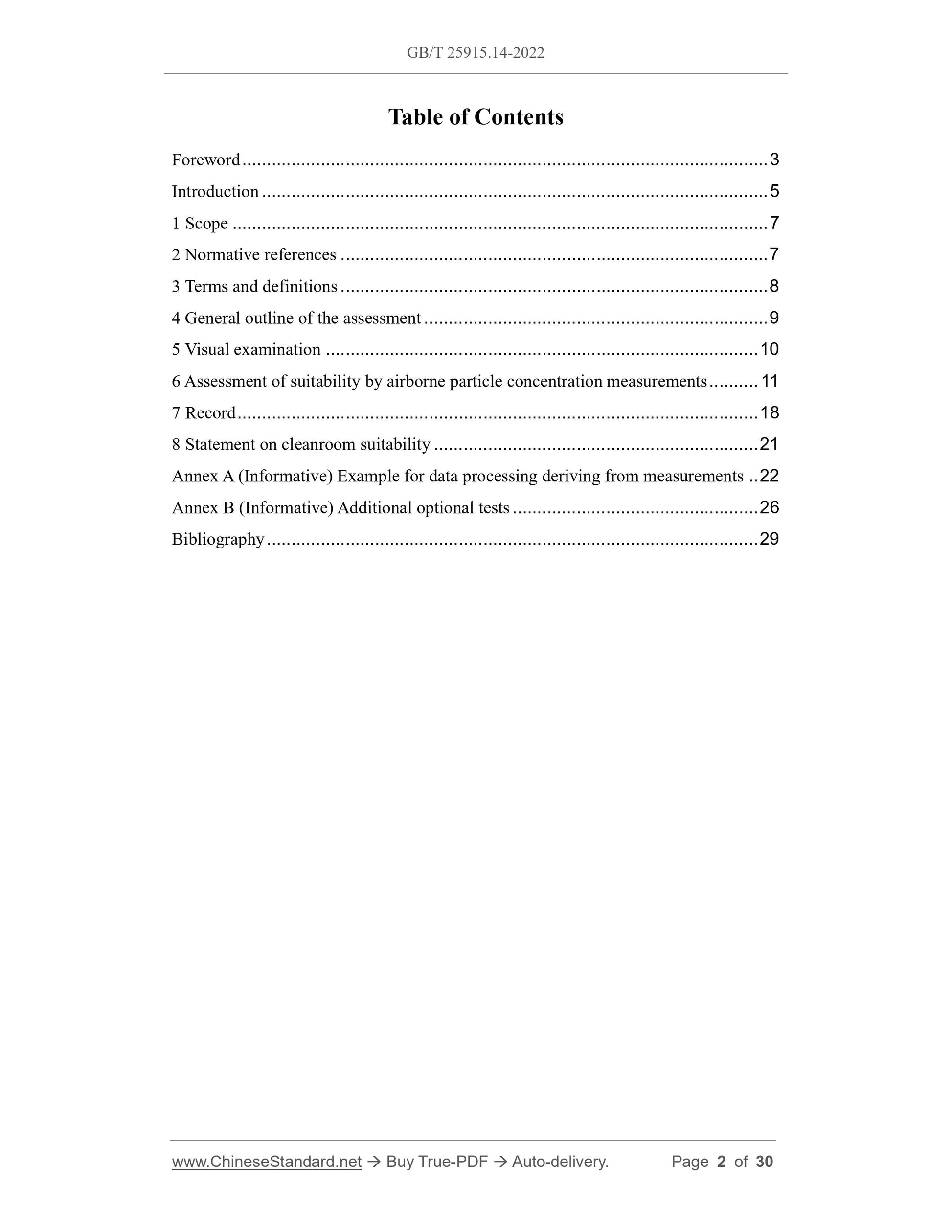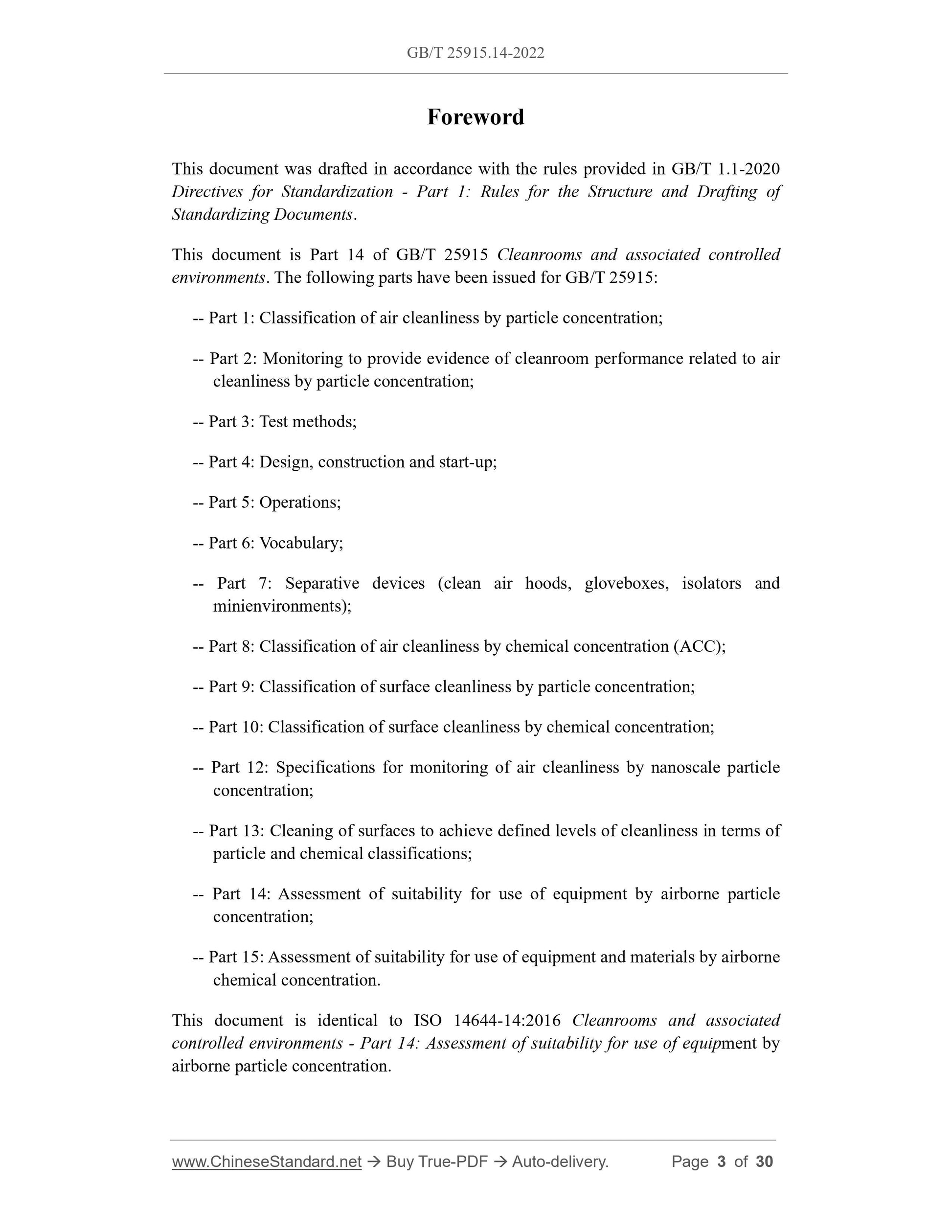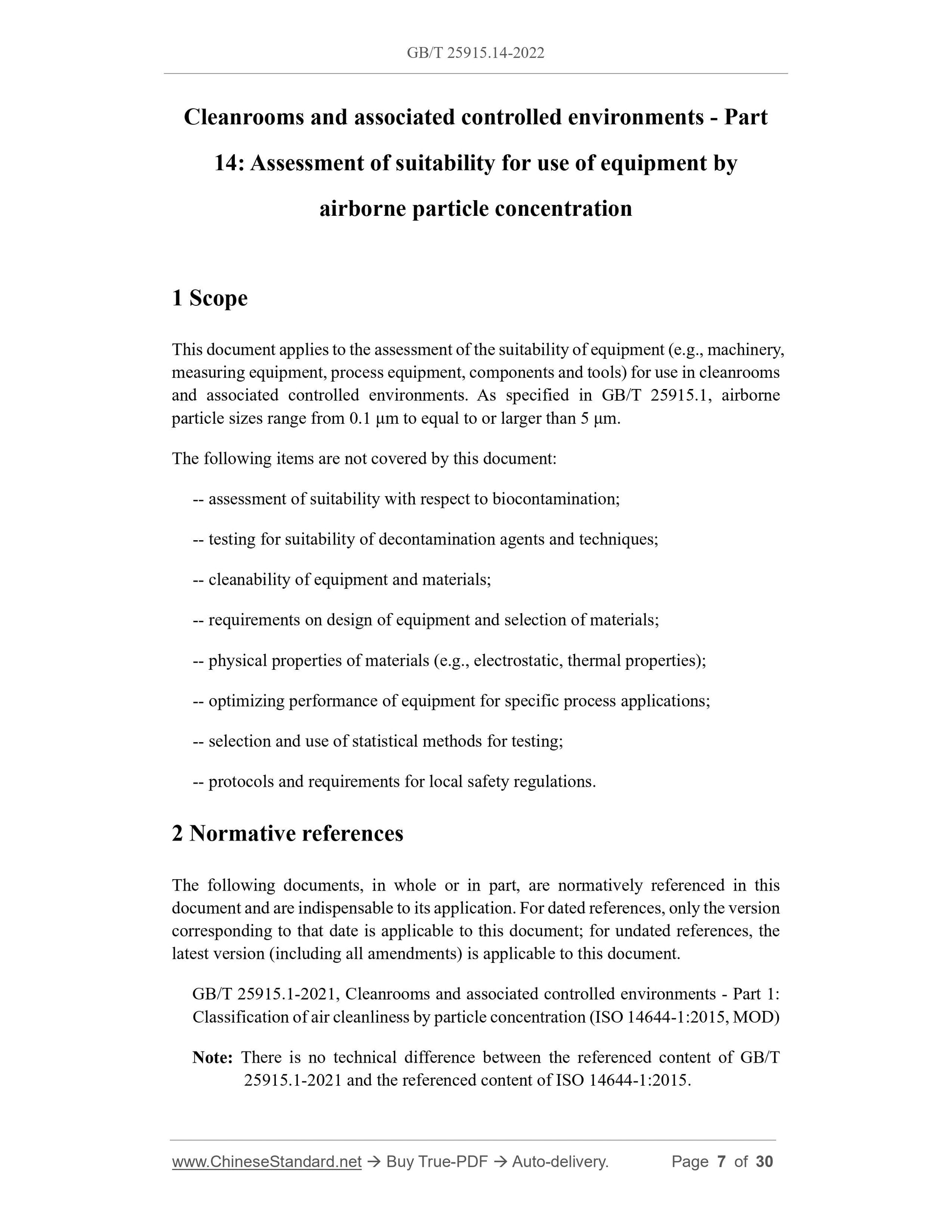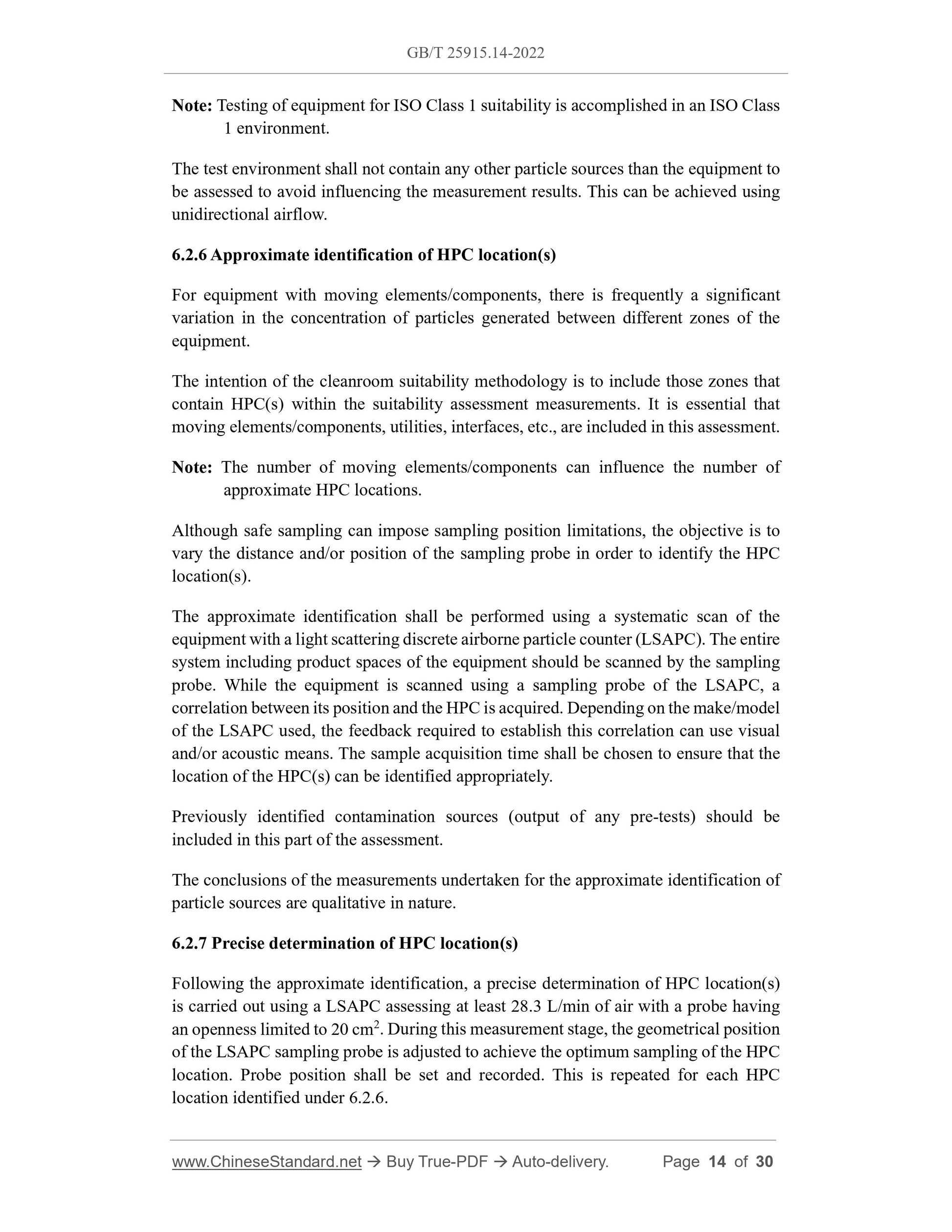1
/
of
5
www.ChineseStandard.us -- Field Test Asia Pte. Ltd.
GB/T 25915.14-2022 English PDF (GB/T25915.14-2022)
GB/T 25915.14-2022 English PDF (GB/T25915.14-2022)
Regular price
$305.00
Regular price
Sale price
$305.00
Unit price
/
per
Shipping calculated at checkout.
Couldn't load pickup availability
GB/T 25915.14-2022: Cleanrooms and associated controlled environments - Part 14: Assessment of suitability for use of equipment by airborne particle concentration
Delivery: 9 seconds. Download (& Email) true-PDF + Invoice.
Get Quotation: Click GB/T 25915.14-2022 (Self-service in 1-minute)
Historical versions (Master-website): GB/T 25915.14-2022
Preview True-PDF (Reload/Scroll-down if blank)
GB/T 25915.14-2022
GB
NATIONAL STANDARD OF THE
PEOPLE’S REPUBLIC OF CHINA
ICS 13.040.35
CCS C 70
GB/T 25915.14-2022 / ISO 14644-14:2016
Cleanrooms and associated controlled environments - Part
14: Assessment of suitability for use of equipment by
airborne particle concentration
(ISO 14644-14:2016, IDT)
ISSUED ON: DECEMBER 30, 2022
IMPLEMENTED ON: JULY 01, 2023
Issued by: State Administration for Market Regulation;
Standardization Administration of the People’s Republic of China.
Table of Contents
Foreword ... 3
Introduction ... 5
1 Scope ... 7
2 Normative references ... 7
3 Terms and definitions ... 8
4 General outline of the assessment ... 9
5 Visual examination ... 10
6 Assessment of suitability by airborne particle concentration measurements ... 11
7 Record ... 18
8 Statement on cleanroom suitability ... 21
Annex A (Informative) Example for data processing deriving from measurements .. 22
Annex B (Informative) Additional optional tests ... 26
Bibliography ... 29
Foreword
This document was drafted in accordance with the rules provided in GB/T 1.1-2020
Directives for Standardization - Part 1: Rules for the Structure and Drafting of
Standardizing Documents.
This document is Part 14 of GB/T 25915 Cleanrooms and associated controlled
environments. The following parts have been issued for GB/T 25915:
-- Part 1: Classification of air cleanliness by particle concentration;
-- Part 2: Monitoring to provide evidence of cleanroom performance related to air
cleanliness by particle concentration;
-- Part 3: Test methods;
-- Part 4: Design, construction and start-up;
-- Part 5: Operations;
-- Part 6: Vocabulary;
-- Part 7: Separative devices (clean air hoods, gloveboxes, isolators and
minienvironments);
-- Part 8: Classification of air cleanliness by chemical concentration (ACC);
-- Part 9: Classification of surface cleanliness by particle concentration;
-- Part 10: Classification of surface cleanliness by chemical concentration;
-- Part 12: Specifications for monitoring of air cleanliness by nanoscale particle
concentration;
-- Part 13: Cleaning of surfaces to achieve defined levels of cleanliness in terms of
particle and chemical classifications;
-- Part 14: Assessment of suitability for use of equipment by airborne particle
concentration;
-- Part 15: Assessment of suitability for use of equipment and materials by airborne
chemical concentration.
This document is identical to ISO 14644-14:2016 Cleanrooms and associated
controlled environments - Part 14: Assessment of suitability for use of equipment by
airborne particle concentration.
Cleanrooms and associated controlled environments - Part
14: Assessment of suitability for use of equipment by
airborne particle concentration
1 Scope
This document applies to the assessment of the suitability of equipment (e.g., machinery,
measuring equipment, process equipment, components and tools) for use in cleanrooms
and associated controlled environments. As specified in GB/T 25915.1, airborne
particle sizes range from 0.1 μm to equal to or larger than 5 μm.
The following items are not covered by this document:
-- assessment of suitability with respect to biocontamination;
-- testing for suitability of decontamination agents and techniques;
-- cleanability of equipment and materials;
-- requirements on design of equipment and selection of materials;
-- physical properties of materials (e.g., electrostatic, thermal properties);
-- optimizing performance of equipment for specific process applications;
-- selection and use of statistical methods for testing;
-- protocols and requirements for local safety regulations.
2 Normative references
The following documents, in whole or in part, are normatively referenced in this
document and are indispensable to its application. For dated references, only the version
corresponding to that date is applicable to this document; for undated references, the
latest version (including all amendments) is applicable to this document.
GB/T 25915.1-2021, Cleanrooms and associated controlled environments - Part 1:
Classification of air cleanliness by particle concentration (ISO 14644-1:2015, MOD)
Note: There is no technical difference between the referenced content of GB/T
25915.1-2021 and the referenced content of ISO 14644-1:2015.
Note: Testing of equipment for ISO Class 1 suitability is accomplished in an ISO Class
1 environment.
The test environment shall not contain any other particle sources than the equipment to
be assessed to avoid influencing the measurement results. This can be achieved using
unidirectional airflow.
6.2.6 Approximate identification of HPC location(s)
For equipment with moving elements/components, there is frequently a significant
variation in the concentration of particles generated between different zones of the
equipment.
The intention of the cleanroom suitability methodology is to include those zones that
contain HPC(s) within the suitability assessment measurements. It is essential that
moving elements/components, utilities, interfaces, etc., are included in this assessment.
Note: The number of moving elements/components can influence the number of
approximate HPC locations.
Although safe sampling can impose sampling position limitations, the objective is to
vary the distance and/or position of the sampling probe in order to identify the HPC
location(s).
The approximate identification shall be performed using a systematic scan of the
equipment with a light scattering discrete airborne particle counter (LSAPC). The entire
system including product spaces of the equipment should be scanned by the sampling
probe. While the equipment is scanned using a sampling probe of the LSAPC, a
correlation between its position and the HPC is acquired. Depending on the make/model
of the LSAPC used, the feedback required to establish this correlation can use visual
and/or acoustic means. The sample acquisition time shall be chosen to ensure that the
location of the HPC(s) can be identified appropriately.
Previously identified contamination sources (output of any pre-tests) should be
included in this part of the assessment.
The conclusions of the measurements undertaken for the approximate identification of
particle sources are qualitative in nature.
6.2.7 Precise determination of HPC location(s)
Following the approximate identification, a precise determination of HPC location(s)
is carried out using a LSAPC assessing at least 28.3 L/min of air with a probe having
an openness limited to 20 cm2. During this measurement stage, the geometrical position
of the LSAPC sampling probe is adjusted to achieve the optimum sampling of the HPC
location. Probe position shall be set and recorded. This is repeated for each HPC
location identified under 6.2.6.
GB/T 25915.14-2022
GB
NATIONAL STANDARD OF THE
PEOPLE’S REPUBLIC OF CHINA
ICS 13.040.35
CCS C 70
GB/T 25915.14-2022 / ISO 14644-14:2016
Cleanrooms and associated controlled environments - Part
14: Assessment of suitability for use of equipment by
airborne particle concentration
(ISO 14644-14:2016, IDT)
ISSUED ON: DECEMBER 30, 2022
IMPLEMENTED ON: JULY 01, 2023
Issued by: State Administration for Market Regulation;
Standardization Administration of the People’s Republic of China.
Table of Contents
Foreword ... 3
Introduction ... 5
1 Scope ... 7
2 Normative references ... 7
3 Terms and definitions ... 8
4 General outline of the assessment ... 9
5 Visual examination ... 10
6 Assessment of suitability by airborne particle concentration measurements ... 11
7 Record ... 18
8 Statement on cleanroom suitability ... 21
Annex A (Informative) Example for data processing deriving from measurements .. 22
Annex B (Informative) Additional optional tests ... 26
Bibliography ... 29
Foreword
This document was drafted in accordance with the rules provided in GB/T 1.1-2020
Directives for Standardization - Part 1: Rules for the Structure and Drafting of
Standardizing Documents.
This document is Part 14 of GB/T 25915 Cleanrooms and associated controlled
environments. The following parts have been issued for GB/T 25915:
-- Part 1: Classification of air cleanliness by particle concentration;
-- Part 2: Monitoring to provide evidence of cleanroom performance related to air
cleanliness by particle concentration;
-- Part 3: Test methods;
-- Part 4: Design, construction and start-up;
-- Part 5: Operations;
-- Part 6: Vocabulary;
-- Part 7: Separative devices (clean air hoods, gloveboxes, isolators and
minienvironments);
-- Part 8: Classification of air cleanliness by chemical concentration (ACC);
-- Part 9: Classification of surface cleanliness by particle concentration;
-- Part 10: Classification of surface cleanliness by chemical concentration;
-- Part 12: Specifications for monitoring of air cleanliness by nanoscale particle
concentration;
-- Part 13: Cleaning of surfaces to achieve defined levels of cleanliness in terms of
particle and chemical classifications;
-- Part 14: Assessment of suitability for use of equipment by airborne particle
concentration;
-- Part 15: Assessment of suitability for use of equipment and materials by airborne
chemical concentration.
This document is identical to ISO 14644-14:2016 Cleanrooms and associated
controlled environments - Part 14: Assessment of suitability for use of equipment by
airborne particle concentration.
Cleanrooms and associated controlled environments - Part
14: Assessment of suitability for use of equipment by
airborne particle concentration
1 Scope
This document applies to the assessment of the suitability of equipment (e.g., machinery,
measuring equipment, process equipment, components and tools) for use in cleanrooms
and associated controlled environments. As specified in GB/T 25915.1, airborne
particle sizes range from 0.1 μm to equal to or larger than 5 μm.
The following items are not covered by this document:
-- assessment of suitability with respect to biocontamination;
-- testing for suitability of decontamination agents and techniques;
-- cleanability of equipment and materials;
-- requirements on design of equipment and selection of materials;
-- physical properties of materials (e.g., electrostatic, thermal properties);
-- optimizing performance of equipment for specific process applications;
-- selection and use of statistical methods for testing;
-- protocols and requirements for local safety regulations.
2 Normative references
The following documents, in whole or in part, are normatively referenced in this
document and are indispensable to its application. For dated references, only the version
corresponding to that date is applicable to this document; for undated references, the
latest version (including all amendments) is applicable to this document.
GB/T 25915.1-2021, Cleanrooms and associated controlled environments - Part 1:
Classification of air cleanliness by particle concentration (ISO 14644-1:2015, MOD)
Note: There is no technical difference between the referenced content of GB/T
25915.1-2021 and the referenced content of ISO 14644-1:2015.
Note: Testing of equipment for ISO Class 1 suitability is accomplished in an ISO Class
1 environment.
The test environment shall not contain any other particle sources than the equipment to
be assessed to avoid influencing the measurement results. This can be achieved using
unidirectional airflow.
6.2.6 Approximate identification of HPC location(s)
For equipment with moving elements/components, there is frequently a significant
variation in the concentration of particles generated between different zones of the
equipment.
The intention of the cleanroom suitability methodology is to include those zones that
contain HPC(s) within the suitability assessment measurements. It is essential that
moving elements/components, utilities, interfaces, etc., are included in this assessment.
Note: The number of moving elements/components can influence the number of
approximate HPC locations.
Although safe sampling can impose sampling position limitations, the objective is to
vary the distance and/or position of the sampling probe in order to identify the HPC
location(s).
The approximate identification shall be performed using a systematic scan of the
equipment with a light scattering discrete airborne particle counter (LSAPC). The entire
system including product spaces of the equipment should be scanned by the sampling
probe. While the equipment is scanned using a sampling probe of the LSAPC, a
correlation between its position and the HPC is acquired. Depending on the make/model
of the LSAPC used, the feedback required to establish this correlation can use visual
and/or acoustic means. The sample acquisition time shall be chosen to ensure that the
location of the HPC(s) can be identified appropriately.
Previously identified contamination sources (output of any pre-tests) should be
included in this part of the assessment.
The conclusions of the measurements undertaken for the approximate identification of
particle sources are qualitative in nature.
6.2.7 Precise determination of HPC location(s)
Following the approximate identification, a precise determination of HPC location(s)
is carried out using a LSAPC assessing at least 28.3 L/min of air with a probe having
an openness limited to 20 cm2. During this measurement stage, the geometrical position
of the LSAPC sampling probe is adjusted to achieve the optimum sampling of the HPC
location. Probe position shall be set and recorded. This is repeated for each HPC
location identified under 6.2.6.
Delivery: 9 seconds. Download (& Email) true-PDF + Invoice.
Get Quotation: Click GB/T 25915.14-2022 (Self-service in 1-minute)
Historical versions (Master-website): GB/T 25915.14-2022
Preview True-PDF (Reload/Scroll-down if blank)
GB/T 25915.14-2022
GB
NATIONAL STANDARD OF THE
PEOPLE’S REPUBLIC OF CHINA
ICS 13.040.35
CCS C 70
GB/T 25915.14-2022 / ISO 14644-14:2016
Cleanrooms and associated controlled environments - Part
14: Assessment of suitability for use of equipment by
airborne particle concentration
(ISO 14644-14:2016, IDT)
ISSUED ON: DECEMBER 30, 2022
IMPLEMENTED ON: JULY 01, 2023
Issued by: State Administration for Market Regulation;
Standardization Administration of the People’s Republic of China.
Table of Contents
Foreword ... 3
Introduction ... 5
1 Scope ... 7
2 Normative references ... 7
3 Terms and definitions ... 8
4 General outline of the assessment ... 9
5 Visual examination ... 10
6 Assessment of suitability by airborne particle concentration measurements ... 11
7 Record ... 18
8 Statement on cleanroom suitability ... 21
Annex A (Informative) Example for data processing deriving from measurements .. 22
Annex B (Informative) Additional optional tests ... 26
Bibliography ... 29
Foreword
This document was drafted in accordance with the rules provided in GB/T 1.1-2020
Directives for Standardization - Part 1: Rules for the Structure and Drafting of
Standardizing Documents.
This document is Part 14 of GB/T 25915 Cleanrooms and associated controlled
environments. The following parts have been issued for GB/T 25915:
-- Part 1: Classification of air cleanliness by particle concentration;
-- Part 2: Monitoring to provide evidence of cleanroom performance related to air
cleanliness by particle concentration;
-- Part 3: Test methods;
-- Part 4: Design, construction and start-up;
-- Part 5: Operations;
-- Part 6: Vocabulary;
-- Part 7: Separative devices (clean air hoods, gloveboxes, isolators and
minienvironments);
-- Part 8: Classification of air cleanliness by chemical concentration (ACC);
-- Part 9: Classification of surface cleanliness by particle concentration;
-- Part 10: Classification of surface cleanliness by chemical concentration;
-- Part 12: Specifications for monitoring of air cleanliness by nanoscale particle
concentration;
-- Part 13: Cleaning of surfaces to achieve defined levels of cleanliness in terms of
particle and chemical classifications;
-- Part 14: Assessment of suitability for use of equipment by airborne particle
concentration;
-- Part 15: Assessment of suitability for use of equipment and materials by airborne
chemical concentration.
This document is identical to ISO 14644-14:2016 Cleanrooms and associated
controlled environments - Part 14: Assessment of suitability for use of equipment by
airborne particle concentration.
Cleanrooms and associated controlled environments - Part
14: Assessment of suitability for use of equipment by
airborne particle concentration
1 Scope
This document applies to the assessment of the suitability of equipment (e.g., machinery,
measuring equipment, process equipment, components and tools) for use in cleanrooms
and associated controlled environments. As specified in GB/T 25915.1, airborne
particle sizes range from 0.1 μm to equal to or larger than 5 μm.
The following items are not covered by this document:
-- assessment of suitability with respect to biocontamination;
-- testing for suitability of decontamination agents and techniques;
-- cleanability of equipment and materials;
-- requirements on design of equipment and selection of materials;
-- physical properties of materials (e.g., electrostatic, thermal properties);
-- optimizing performance of equipment for specific process applications;
-- selection and use of statistical methods for testing;
-- protocols and requirements for local safety regulations.
2 Normative references
The following documents, in whole or in part, are normatively referenced in this
document and are indispensable to its application. For dated references, only the version
corresponding to that date is applicable to this document; for undated references, the
latest version (including all amendments) is applicable to this document.
GB/T 25915.1-2021, Cleanrooms and associated controlled environments - Part 1:
Classification of air cleanliness by particle concentration (ISO 14644-1:2015, MOD)
Note: There is no technical difference between the referenced content of GB/T
25915.1-2021 and the referenced content of ISO 14644-1:2015.
Note: Testing of equipment for ISO Class 1 suitability is accomplished in an ISO Class
1 environment.
The test environment shall not contain any other particle sources than the equipment to
be assessed to avoid influencing the measurement results. This can be achieved using
unidirectional airflow.
6.2.6 Approximate identification of HPC location(s)
For equipment with moving elements/components, there is frequently a significant
variation in the concentration of particles generated between different zones of the
equipment.
The intention of the cleanroom suitability methodology is to include those zones that
contain HPC(s) within the suitability assessment measurements. It is essential that
moving elements/components, utilities, interfaces, etc., are included in this assessment.
Note: The number of moving elements/components can influence the number of
approximate HPC locations.
Although safe sampling can impose sampling position limitations, the objective is to
vary the distance and/or position of the sampling probe in order to identify the HPC
location(s).
The approximate identification shall be performed using a systematic scan of the
equipment with a light scattering discrete airborne particle counter (LSAPC). The entire
system including product spaces of the equipment should be scanned by the sampling
probe. While the equipment is scanned using a sampling probe of the LSAPC, a
correlation between its position and the HPC is acquired. Depending on the make/model
of the LSAPC used, the feedback required to establish this correlation can use visual
and/or acoustic means. The sample acquisition time shall be chosen to ensure that the
location of the HPC(s) can be identified appropriately.
Previously identified contamination sources (output of any pre-tests) should be
included in this part of the assessment.
The conclusions of the measurements undertaken for the approximate identification of
particle sources are qualitative in nature.
6.2.7 Precise determination of HPC location(s)
Following the approximate identification, a precise determination of HPC location(s)
is carried out using a LSAPC assessing at least 28.3 L/min of air with a probe having
an openness limited to 20 cm2. During this measurement stage, the geometrical position
of the LSAPC sampling probe is adjusted to achieve the optimum sampling of the HPC
location. Probe position shall be set and recorded. This is repeated for each HPC
location identified under 6.2.6.
GB/T 25915.14-2022
GB
NATIONAL STANDARD OF THE
PEOPLE’S REPUBLIC OF CHINA
ICS 13.040.35
CCS C 70
GB/T 25915.14-2022 / ISO 14644-14:2016
Cleanrooms and associated controlled environments - Part
14: Assessment of suitability for use of equipment by
airborne particle concentration
(ISO 14644-14:2016, IDT)
ISSUED ON: DECEMBER 30, 2022
IMPLEMENTED ON: JULY 01, 2023
Issued by: State Administration for Market Regulation;
Standardization Administration of the People’s Republic of China.
Table of Contents
Foreword ... 3
Introduction ... 5
1 Scope ... 7
2 Normative references ... 7
3 Terms and definitions ... 8
4 General outline of the assessment ... 9
5 Visual examination ... 10
6 Assessment of suitability by airborne particle concentration measurements ... 11
7 Record ... 18
8 Statement on cleanroom suitability ... 21
Annex A (Informative) Example for data processing deriving from measurements .. 22
Annex B (Informative) Additional optional tests ... 26
Bibliography ... 29
Foreword
This document was drafted in accordance with the rules provided in GB/T 1.1-2020
Directives for Standardization - Part 1: Rules for the Structure and Drafting of
Standardizing Documents.
This document is Part 14 of GB/T 25915 Cleanrooms and associated controlled
environments. The following parts have been issued for GB/T 25915:
-- Part 1: Classification of air cleanliness by particle concentration;
-- Part 2: Monitoring to provide evidence of cleanroom performance related to air
cleanliness by particle concentration;
-- Part 3: Test methods;
-- Part 4: Design, construction and start-up;
-- Part 5: Operations;
-- Part 6: Vocabulary;
-- Part 7: Separative devices (clean air hoods, gloveboxes, isolators and
minienvironments);
-- Part 8: Classification of air cleanliness by chemical concentration (ACC);
-- Part 9: Classification of surface cleanliness by particle concentration;
-- Part 10: Classification of surface cleanliness by chemical concentration;
-- Part 12: Specifications for monitoring of air cleanliness by nanoscale particle
concentration;
-- Part 13: Cleaning of surfaces to achieve defined levels of cleanliness in terms of
particle and chemical classifications;
-- Part 14: Assessment of suitability for use of equipment by airborne particle
concentration;
-- Part 15: Assessment of suitability for use of equipment and materials by airborne
chemical concentration.
This document is identical to ISO 14644-14:2016 Cleanrooms and associated
controlled environments - Part 14: Assessment of suitability for use of equipment by
airborne particle concentration.
Cleanrooms and associated controlled environments - Part
14: Assessment of suitability for use of equipment by
airborne particle concentration
1 Scope
This document applies to the assessment of the suitability of equipment (e.g., machinery,
measuring equipment, process equipment, components and tools) for use in cleanrooms
and associated controlled environments. As specified in GB/T 25915.1, airborne
particle sizes range from 0.1 μm to equal to or larger than 5 μm.
The following items are not covered by this document:
-- assessment of suitability with respect to biocontamination;
-- testing for suitability of decontamination agents and techniques;
-- cleanability of equipment and materials;
-- requirements on design of equipment and selection of materials;
-- physical properties of materials (e.g., electrostatic, thermal properties);
-- optimizing performance of equipment for specific process applications;
-- selection and use of statistical methods for testing;
-- protocols and requirements for local safety regulations.
2 Normative references
The following documents, in whole or in part, are normatively referenced in this
document and are indispensable to its application. For dated references, only the version
corresponding to that date is applicable to this document; for undated references, the
latest version (including all amendments) is applicable to this document.
GB/T 25915.1-2021, Cleanrooms and associated controlled environments - Part 1:
Classification of air cleanliness by particle concentration (ISO 14644-1:2015, MOD)
Note: There is no technical difference between the referenced content of GB/T
25915.1-2021 and the referenced content of ISO 14644-1:2015.
Note: Testing of equipment for ISO Class 1 suitability is accomplished in an ISO Class
1 environment.
The test environment shall not contain any other particle sources than the equipment to
be assessed to avoid influencing the measurement results. This can be achieved using
unidirectional airflow.
6.2.6 Approximate identification of HPC location(s)
For equipment with moving elements/components, there is frequently a significant
variation in the concentration of particles generated between different zones of the
equipment.
The intention of the cleanroom suitability methodology is to include those zones that
contain HPC(s) within the suitability assessment measurements. It is essential that
moving elements/components, utilities, interfaces, etc., are included in this assessment.
Note: The number of moving elements/components can influence the number of
approximate HPC locations.
Although safe sampling can impose sampling position limitations, the objective is to
vary the distance and/or position of the sampling probe in order to identify the HPC
location(s).
The approximate identification shall be performed using a systematic scan of the
equipment with a light scattering discrete airborne particle counter (LSAPC). The entire
system including product spaces of the equipment should be scanned by the sampling
probe. While the equipment is scanned using a sampling probe of the LSAPC, a
correlation between its position and the HPC is acquired. Depending on the make/model
of the LSAPC used, the feedback required to establish this correlation can use visual
and/or acoustic means. The sample acquisition time shall be chosen to ensure that the
location of the HPC(s) can be identified appropriately.
Previously identified contamination sources (output of any pre-tests) should be
included in this part of the assessment.
The conclusions of the measurements undertaken for the approximate identification of
particle sources are qualitative in nature.
6.2.7 Precise determination of HPC location(s)
Following the approximate identification, a precise determination of HPC location(s)
is carried out using a LSAPC assessing at least 28.3 L/min of air with a probe having
an openness limited to 20 cm2. During this measurement stage, the geometrical position
of the LSAPC sampling probe is adjusted to achieve the optimum sampling of the HPC
location. Probe position shall be set and recorded. This is repeated for each HPC
location identified under 6.2.6.
Share
